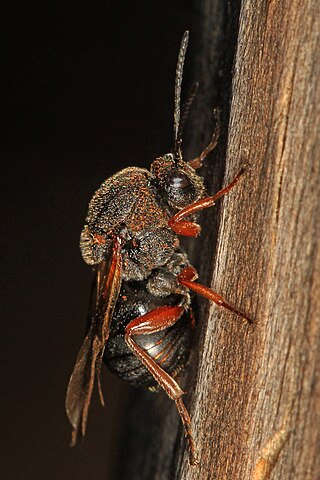
Diplolepis is a genus of approximately fifty species of gall-inducing wasps in the family Diplolepididae. The larvae induce galls on wild roses (Rosa), and rarely on domestic roses.

Gall wasps, also traditionally calledgallflies, are hymenopterans of the family Cynipidae in the wasp superfamily Cynipoidea. Their common name comes from the galls they induce on plants for larval development. About 1,300 species of this generally very small creature are known worldwide, with about 360 species of 36 different genera in Europe and some 800 species in North America.

Andricus is a genus of oak gall wasps in the family Cynipidae.

Cynipinae is a subfamily of gall wasps (Cynipidae). Many of the approximately 1,500 described species cause galls on oaks, but some induce galls on other plant species or are inquilines of the gall-inducing species. Species occur on all continents except Antarctica, with most found in the temperate regions of the northern hemisphere. All extant cynipid species are within Cynipinae since the only other recognized subfamily is Hodiernocynipinae which is based on the fossil genus Hodiernocynips.

Cynipini is a tribe of gall wasps. These insects induce galls in plants of the beech and oak family, Fagaceae. They are known commonly as the oak gall wasps. It is the largest cynipid tribe, with about 936 to 1000 recognized species, most of which are associated with oaks. The tribe is mainly native to the Holarctic.
Cecinothofagus gallaecoihue is a species of gall wasp. Cecinothofagus species are thought to be parasitoids or lethal inhabitants of galls induced by species of Aditrochus on Nothofagus.
Cecinothofagus gallaelenga is a species of gall wasp. Cecinothofagus species are thought to be parasitoids or lethal inhabitants of galls induced by species of Aditrochus on Nothofagus.
Cecinothofagus ibarrai is a species of gall wasp. Cecinothofagus species are thought to be parasitoids or lethal inhabitants of galls induced by species of Aditrochus on Nothofagus.
Cecinothofagus is a genus of wasps. Its name is derived from cecidium and Nothofagus, the name of the host plant genus. This genus differs from Paraulax by a median vertical carina that extends from the ventral margin of the clypeus, almost reaching the ventral margin of the antennal sockets; its facial strigae radiating from the lateral clypeus; the ventral part of its clypeus is straight; a lateral, sharp occipital carina is present; its last antennal flagellomere is 1.5 to 1.7 times longer than wide; longitudinal costulae running from the lateral margin of its pronotal plate to the lateral surface of its pronotum are very short or absent altogether; notauli are sinuate; no scutellar foveae are present; simple claws, sometimes carrying a short basal lobe.
Bassettia is a genus of gall wasps found in North America.
Synergini is a tribe of gall wasps in the subfamily Cynipinae.

Amphibolips is an American genus of gall wasps in the family Cynipidae. There are about 57 described species in the genus Amphibolips with several others still undescribed.

Diastrophus is a genus of gall wasps in the family Cynipidae. There are at least eight described species in Diastrophus.

Disholcaspis is a genus of gall wasps in the family Cynipidae. There are more than 40 species described in the genus Disholcaspis. Some Disholcaspis species induce galls that produce honeydew, a sweet liquid that attracts yellow jackets, ants, and bees. These insects then protect the galls from parasitic wasps.

Callirhytis is a genus of gall wasps in the family Cynipidae. There are more than 90 described species in Callirhytis. Wasps in this genus primarily induce wasps on oak trees in North America.
Ceroptresini is a tribe of oak gall wasps in the family Cynipidae, and includes two genera: Ceroptres and Buffingtonella. All but one of the 22 species currently recognized are in Ceroptres. Ceroptresini, containing only Ceroptres, was first proposed as a tribe in 2015, and Buffingtonella was included the tribe in 2019 when the genus was first described. Species in this tribe are believed to be inquilines in galls induced by other gall wasps but this has not been confirmed.

Phylloteras is a North American genus of gall wasps in the family Cynipidae, tribe Cynipini .

Kokkocynips is an American genus of gall wasps in the family Cynipidae. There are about 8 described species in the genus Kokkocynips with several others still undescribed.

Diplolepididae is a family of small gall-inducing wasps. Until recently these wasps were included in the gall wasp family (Cynipidae) but were moved to their own family based on genetic and morphological features. It contains two subfamilies: Diplolepidinae and Pediaspidinae.











